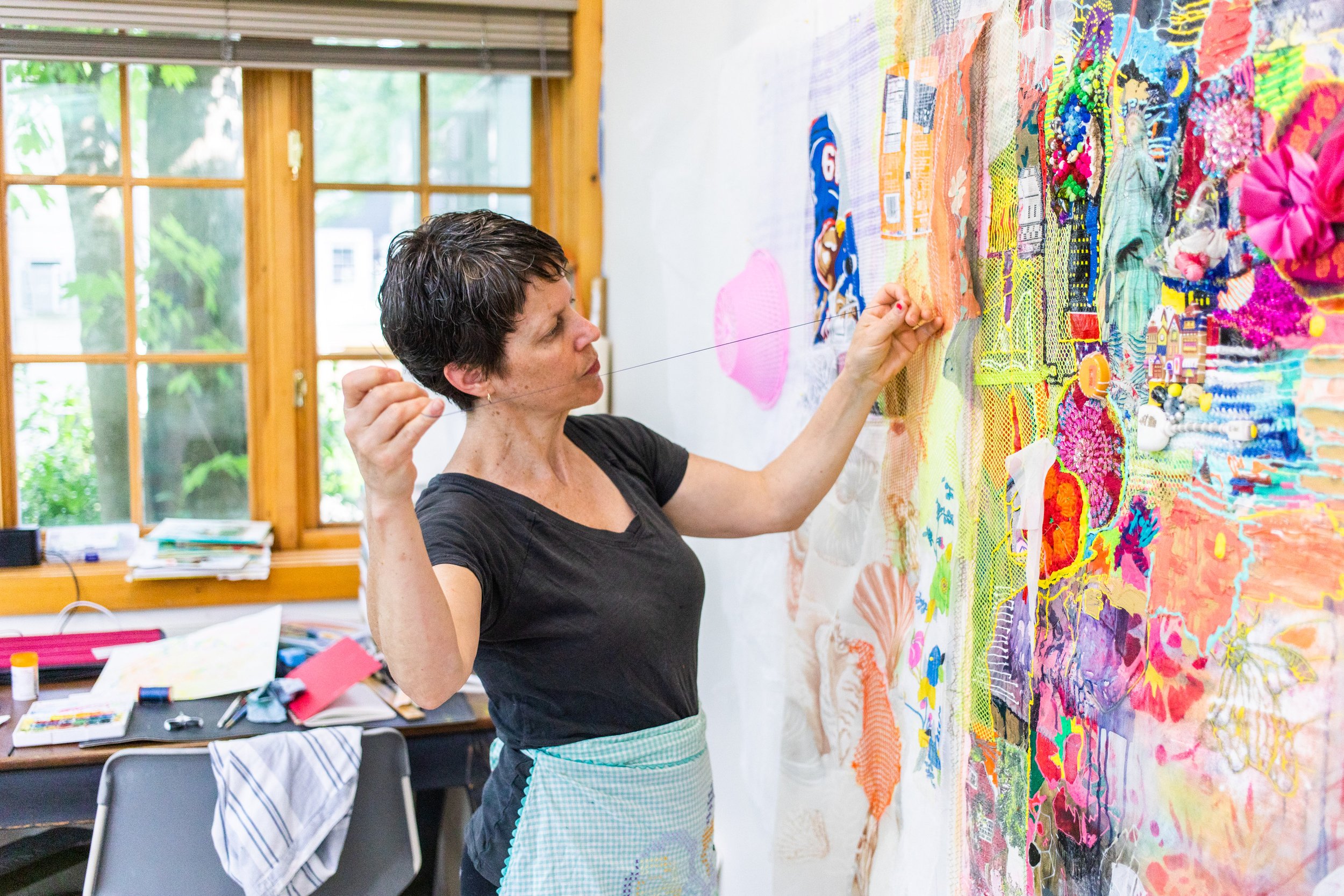
We Are in Danger, 2022
Master upcyclist and Tulsa-native artist Julie Peppito is in the CAMP Spotlight this month, August 2024. Signature to her work is the candy-crush kaleidoscope of fiber, discarded materials, and paint that is assembled into intricate, nostalgic pieces. The artist draws inspiration from found objects, using them to create narratives that explore human connection and environmental themes.
Read more for a glimpse into Peppito's discussion on connection and process-both among humans and with the Earth-and how it ties in to the narratives she creates.

Julie peppito in her studio. Courtesy of the artist.
How do the materials you choose influence the meaning or interpretation of your work?
The debris, Americana and images that I find on the street, in thrift stores, and that are given to me are the inspiration for the unusual narratives within my sculptures, tapestries and paintings. I am interested in combining all of the things I find into surfaces that merge and blend together like moss covers the ground. My overall narrative is always about connection. By smashing, nailing, wrapping and sewing these found things together I create visual metaphors for human connection to the Earth and to one another.
How have you been able to find balance between inspiration and discipline in your creative process?
Not very well! I'm still working on it. The best I have been able to do is give myself grace and accept the fact that this is not my strength and that I am a work in progress. My art is very process-oriented and so am I. I am sure I have extreme ADHD, though I've never been diagnosed. I focus on whatever is in front of me at the moment and get distracted easily. I have to set aside time to make art and set timers to begin. If my studio is a mess, which it often is due to the extraordinary amount of materials and modalities I use, I can spend hours or days cleaning. It is through cleaning that I discover my materials again and become inspired. It is a very inexact science. If I have a deadline that brings me into sharp (though stressed out) focus. I get it done but I always wish I had more time.
What role does color play in how you wish to convey the narrative in your pieces?
The color of the objects I find usually dictate the colors in the piece. If it is a pink Barbie camper, the piece will be "Barbie pink" and bring with it all of the narrative symbolism imbued in that color.
Julie Peppito. "To be determined" 2022.
What's a typical day like for you at the studio? Are there any routines or rituals you do to aid your process?
I put on Democracy Now! (a people funded non-profit news show) and know that I have a set hour where my brain is distracted by the news - It occupies part of my brain so that the other part is available for creating. Then, if my studio is clean, I dump out bins of junk, and make it dirty again. (Sometimes I really feel like a crazy person.) I sift through the piles of toys, plumbing, sticks, images, beads, fabric, etc... I put things next to each other and see what stories come up for me. I also look in my sketchbooks where there are ideas for all of my formats: sculpture, tapestry, painting, installation, public art, and wearables.
I decide what my focus will be for that time period. Often it has to do with what show is coming up. For example, I have a solo exhibit of tapestries coming up in May of 2025 at CAMP. I am pivoting towards making tapestries for that so I've been dumping out my fabric bins, smashing flat plastic and drilling holes in it, and sifting through imagery to see what combinations of things will tell the stories I want to tell. Those stories will be organic in shape and size, they will be sewn, focusing on layers - those materials and processes will influence the narrative.
I have also been working on stretched canvas for an exhibit at Heskin projects, at GAP 1 Gallery in Brooklyn coming up in September. For those paintings I start with finding stretched canvases that I've had for years that I can paint over, then I look at paintings by artists that inspire me who use rich and unusual color; Paul Klee and Stuart Davis come to mind but there are many artists who inspire me for color. I also look at vintage fabrics and old illustrations from Golden encyclopedias for color and imagery.
Since the old things that I acquire for my art are intrinsically nostalgic, the love that people feel for their childhood and past is often a large part of my narratives. I contrast that with nature and trash to lean towards a message of environmental preservation and connection.
Sorry, I went off topic a bit. I will often go off topic in the studio too. It's like when you spend hours looking through old family photos when you are supposed to be packing up boxes to move. That's a bit like my studio practice. If I really need to get something done - which I often do since I also teach out of my studio, then I will set timers to make sure I begin again.
What's your favorite non-artistic hobby, and how does it influence your work, if at all?
I don't have any, except perhaps eating delicious food. But, that is often combined with drawing.
My partner, Gideon Kendall, and I have date nights where we go out to eat and we make collaborative drawings. Sometimes the imagery from these drawings seeps into my other art. It sometimes feels like the purest, least overthought and overwrought thing that I make.



